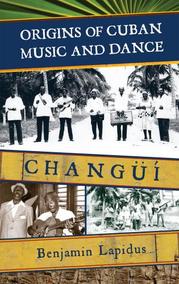New York and the International Sound of Latin Music, 1940-1990 (University Press of Mississippi, 2021), An assessment, celebration, and careful notation of the extraordinary melting pot of Latin music.
Press
- A Sound as International as the City Itself: A Review of Benjamin Lapidus’ NEW YORK AND THE INTERNATIONAL SOUND OF LATIN MUSIC, 1940-1990
- Review: New York and the International Sound of Latin Music (1940-1990)
- New York City’s Influence On Latin Music
- BBC 3 Music Matters, May 8, 2020
Reviews
“I had been waiting a long time for a comprehensive historical assessment of New York as the capital of Latin music in the mid-twentieth century. Benjamin Lapidus far exceeds expectations. His multilayered portrait is ambitious, meticulous, surprising, and a delight to read. Bravissimo!”
– Ilan Stavans, Lewis-Sebring Professor of Humanities and Latin American and Latino Culture at Amherst College
“In the enormous casserole that Lapidus uses to present this history, he does not forget an ingredient that many other authors leave out: women. And this musical chef, Lapidus, presents it in exquisite form. Enjoy it, bon appétit!”
– Dr. Cristóbal Díaz Ayala, namesake of the Cristóbal Díaz Ayala Collection of Cuban and Latin American music at Florida International University
“The result is a comprehensive assessment of New York as the capital of Latin music from 1940 to 1990, as told by an active participant and an eyewitness. ”
– Tomas Peña, JazzDeLaPena
“New York and the International Sound of Latin Music, 1940-1990 is an important foundation for such endeavors and should inspire historians to think about how Gotham’s diverse population helped shape 20th-century musical traditions that were simultaneously American and Latinx. ”
– Matthew Pessar Joseph, Gotham: A Blog for Scholars of New York City History
“There are very few books that document the origin and development of Latin music in the US. This work is of tremendous importance because it illustrates many unknown facts about Latin musicians’ identities and contributions to the Latin and jazz genres that would have continued to be ignored, if not rescued by Ben Lapidus and his reporting. The book is obligatory reading, and I fully recommend it. ”
– Rubén Blades, Panamanian musician, singer, composer, actor, activist, and politician
“Based on extended interviews and incorporating insightful musical analysis, the author explores an array of fascinating topics: the history of Latin music pedagogy, the history of instrument makers and innovators, the contributions of Panamanian and Jewish musicians, the influence of female musicians and entrepreneurs, and the impact of the Mariel exodus on performance, to name only a few. ”
– Robin D. Moore, professor of ethnomusicology at the University of Texas at Austin
“Lapidus’s book is a much-needed detailed history of Latin dance music’s storied place in New York City, giving the reader unique insights into the complexities and richness of the history of this music. ”
– David F. Garcia, author of Listening for Africa: Freedom, Modernity, and the Logic of Black Music’s African Origins
“A major achievement, this book exuberantly shares with its readers the richness of music making during an extraordinarily fecund period of New York City’s history. ”
– Jairo Moreno, author of Musical Representations, Subjects, and Objects: The Construction of Musical Thought in Zarlino, Descartes, Rameau, and Weber
Origins of Cuban Music and Dance: Changüí (Scarecrow Press, 2008) is the first and only in-depth study written in English or Spanish on the changüí music and dance genre of Guantánamo, Cuba.

In this ground-breaking study of changüí, Ben Lapidus sheds light on a lesser-known but important genre of Cuban music, providing detailed analysis of its musical form while at the same time situating it in the broader context of eastern Cuba’s unique history and music culture.
-Peter Manuel, CUNY Graduate Center
Lapidus synthesizes his ethnographic and historical research to present an indispensable text on one of Cuba’s and the Caribbean’s least documented and studied musical and dance genres. The author argues for an ethnographically-based alternative to the standard evolutionary construction of the Cuban son’s historical development by showing that changüí, nengón, and kiribá—the son’s perceived “antecedents”—are not only distinct in their performative dimensions, but they also continue to contribute in their own idiosyncratic ways to the local and contemporary soundscape of Guantanamo. Herein lies Lapidus’s major scholarly contribution to the kind of popular music studies that eschews a linear evolutionary framework of music history and instead focuses on the meanings generated where memory, history, performance, and the local, national, and transnational intersect.
-David F. García, assistant professor, ethnomusicology, UNC – Chapel Hill
“¡Este bongó que te llama!: El changüí guantanamero y las influencias extranjeras en el son cubano,” in El son y la salsa en la identidad del Caribe edited by Darío Tejeda (Santiago de los Caballeros, Dominican Republic: Instituto de estudios caribeños, 2008): 339-350.
“Yo tengo sentido, tengo rima: Cano Estremera and the Art of the Soneo,” in Centro: Journal of the Center for Puerto Rican Studies Puerto Rican Music: RicanStructing Roots and Routes, vol. 2 (October 2004).
“¡Toca maravilloso! Larry Harlow and the Jewish Connection to Latin music” 9789004184473_08-Lapidus-2.Mazal Tov, Amigos!: Jews and Popular Music (edited by Amalia Ran and Moshe Morad) Brill 2016: 109-121.
